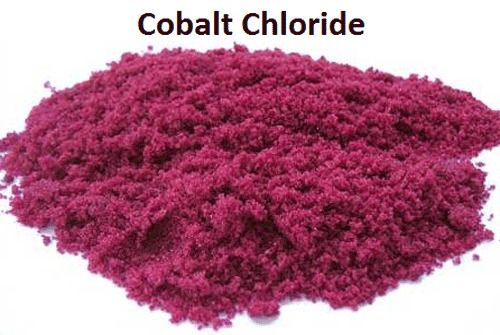

- #COBALT CHLORIDE SKIN#
- #COBALT CHLORIDE SERIES#
A violet-coloured solution should be formed.
Make the pink cobalt chloride solution up to 100 cm 3 with 60 cm 3 concentrated hydrochloric acid from a measuring cylinder. A reddish-pink, approximately 0.4 M solution will be formed, which should be labelled as TOXIC. Dissolve about 4 g of cobalt(II) chloride-6-water in 40 cm 3 of water in a beaker.  Boil a beaker of water and prepare a beaker of crushed ice and water. Concentrated hydrochloric acid, HCl(aq), (CORROSIVE) – see to CLEAPSS Hazcard HC047a.
Boil a beaker of water and prepare a beaker of crushed ice and water. Concentrated hydrochloric acid, HCl(aq), (CORROSIVE) – see to CLEAPSS Hazcard HC047a. #COBALT CHLORIDE SKIN#
As cobalt(II) chloride is a skin sensitiser, take care to avoid skin contact and wash hands well after use.
Cobalt(II) chloride–6–water, CoCl 2.6H 2O(s), (TOXIC, DANGEROUS FOR THE ENVIRONMENT) – see CLEAPSS Hazcard HC025. Read our standard health and safety guidance. Concentrated hydrochloric acid (CORROSIVE), 100 cm 3. Cobalt(II) chloride-6-water (TOXIC, DANGEROUS FOR THE ENVIRONMENT), 4.0 g. Rack for boiling tubes x1 or x2 (depending on capacity). The demonstration could also be adapted for use as a class experiment with suitable groups. For big groups the reactions should be scaled up, using larger containers such as measuring cylinders or beakers, to improve visibility. Pink cobalt species + chloride ions ⇌ Blue cobalt species + water moleculesĪ white background will help to show the colour changes to best effect. For the purposes of this discussion the equilibrium could adequately be represented by: If students are unfamiliar with the formulae of complex ions this may confuse the issue. The demonstration can be used to introduce reversible reactions and chemical equilibrium or to illustrate Le Chatelier’s principle once these concepts have been established. The distinctive colours of the two cobalt(II) species in solution produce an attractive visual demonstration of a reversible reaction and the effect of concentration and temperature on the position of equilibrium. The colour changes accompanying the changes in equilibrium position are as predicted by Le Chatelier’s principle. This equilibrium can be disturbed by changing the chloride ion concentration or by changing the temperature. The two different coloured Co(II) complex ions, 2+ and 2-, exist together in equilibrium in solution in the presence of chloride ions: Hamied Inspirational Chemistry Programme. Introductory maths for higher education. The physics of restoration and conservation. Nickel-cobalt laterite ores can either be melted and separated using pyrometallurgical techniques or hydrometallurgical techniques, which use sulfuric acid or ammonia leach solutions. From this cobalt is recovered by electrorefining or carbonate precipitation. The ores are then treated with hydrochloric acid and chlorine, or with sulfuric acid, to create a leach solution that is purified.  Arsenide ores are roasted to remove the majority of arsenic oxide.
Arsenide ores are roasted to remove the majority of arsenic oxide. 
Pressure leaching with air, sulfuric acid, and ammonia recover more nickel before cobalt powder is added as a seed to precipitate cobalt in a hydrogen gas atmosphere.
#COBALT CHLORIDE SERIES#
Both copper and nickel are both removed in a series of chemical reduction processes, leaving only nickel and cobalt sulfides. In this process, sulfide concentrate containing less than 1% cobalt is pressure leached at high temperatures in an ammonia solution. Cobalt-containing nickel sulfide ores are treated using the Sherritt process, named after Sherritt Gordon Mines Ltd.Cobalt metal can then be refined from this using electrolysis, before being crushed and degassed to produce a pure, commercial-grade metal. Impurities (iron, nickel, copper, zinc) are removed, and cobalt is precipitated in its hydroxide form using lime. After copper cathodes are produced from cobalt-containing copper sulfides, cobalt, along with other impurities, are left on the spent electrolyte.








 0 kommentar(er)
0 kommentar(er)
